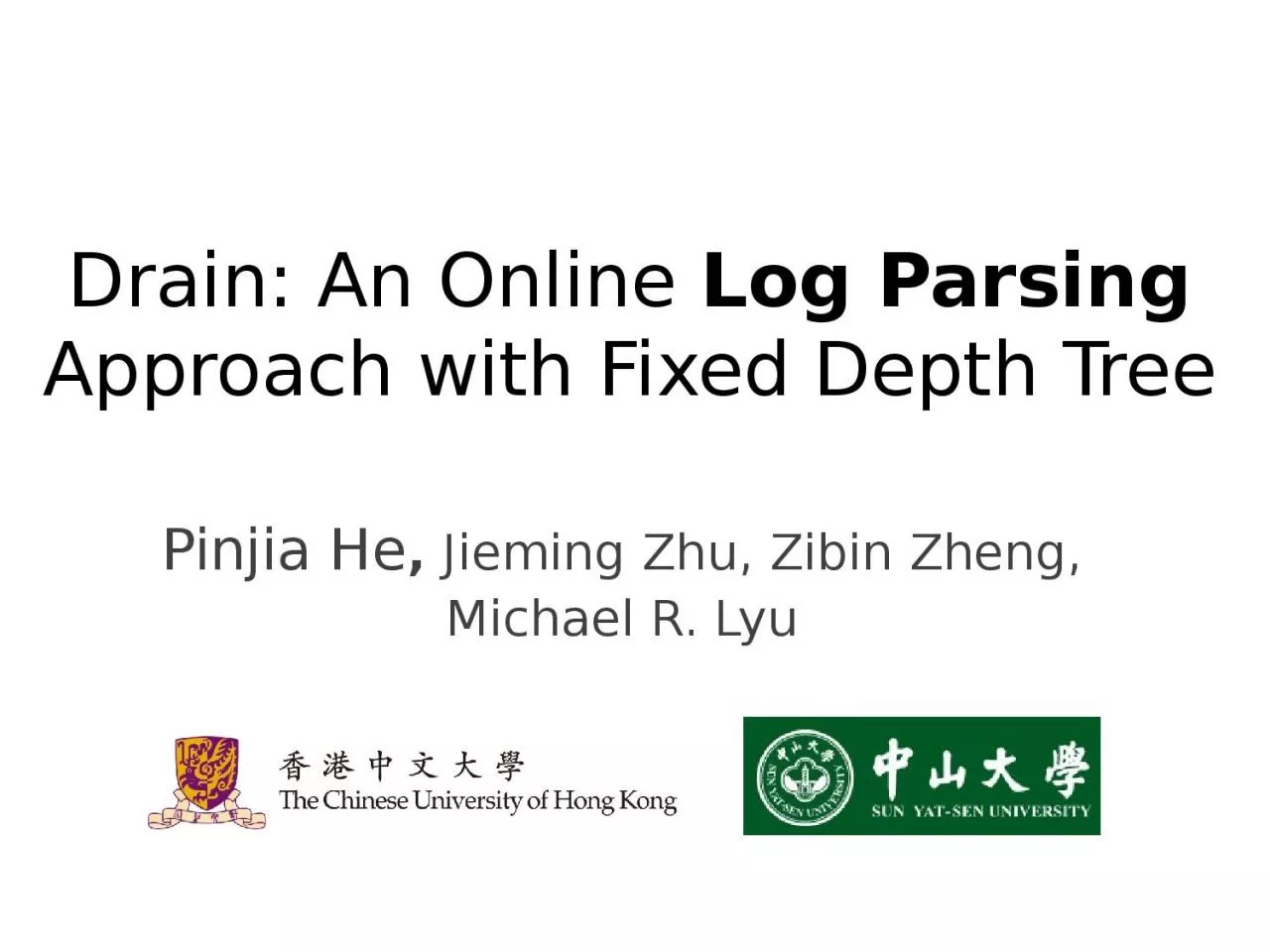

Approach with Fixed Depth Tree P injia He Jieming Zhu Zibin Zheng Michael R Lyu 2 More and more developers leverage Web services to build their own systems Image from httpwwwlinuxnixcomunderstandingawsamazonwebservicescloudpart ID: 1045929
Download Presentation The PPT/PDF document "Drain: An Online Log Parsing" is the property of its rightful owner. Permission is granted to download and print the materials on this web site for personal, non-commercial use only, and to display it on your personal computer provided you do not modify the materials and that you retain all copyright notices contained in the materials. By downloading content from our website, you accept the terms of this agreement.
1. Drain: An Online Log Parsing Approach with Fixed Depth TreePinjia He, Jieming Zhu, Zibin Zheng, Michael R. Lyu
2. 2More and more developers leverage Web services to build their own systems[Image from: http://www.linuxnix.com/understanding-awsamazon-web-services-cloud-part/][Image from: http://www.fruitionsystems.co.uk/cloud-services/azure/][Image from: http://www.lifehack.org/articles/technology/you-may-never-know-these-google-search-tips-and-tricks-you-miss-this.html]
3. 3Web services management isa big challenge, due to increasing scale and complexity Service Providers Service Users
4. Logs are a pervasive data source produced by Web services;Log analysis is widely-employed for quality management of Web services4
5. Logs are unstructured52008-11-11 03:41:48 Received block blk_90 of size 67108864 from /10.250.18.114Raw LogWhat’s this? I only understand structured dataLog Analysis AI
6. Log analysis models require structured input62008-11-11 03:41:48 Received block blk_90 of size 67108864 from /10.250.18.114Raw LogOh! This is Event 1 happened on block blk_90Log Analysis AI blk_90 -> Event 1: Received block * of size * from *Structured LogLog Parsing
7. Log Parsing Example72008-11-11 03:41:48 Received block blk_90 of size 67108864 from /10.250.18.114 blk_90 -> Event 1: Received block * of size * from *Raw LogStructured LogLog ParsingField of InterestLog Event
8. Log Parsing Example8Raw LogLog ParsingThe goal of log parsing is to distinguish between constant part and variable part from the log contents.Structured Log2008-11-11 03:41:48 Received block blk_90 of size 67108864 from /10.250.18.114 blk_90 -> Event 1: Received block * of size * from *
9. Log parsing is a small step in the whole process of log analysis for anomaly detection, but it is a significant step!And it is non-trivial to do so!9
10. 10Existing log parsing methodsManual maintenance of log events (i.e., regular expressions)The volume of logDeveloper may not understand the logging purpose Logging statements update frequentlyOffline log parsers. Selection of training logsLog event changes
11. An online log parser is highly in demand11
12. Framework of Drain12A List of Log Groups . . . Length: 4 . . . RootLength: 5Length: 10SendReceiveStartingLog Event: Receive from node *Log IDs: [1, 23, 25, 46, 345, …]Log GroupRoot NodeInternal NodeLeaf NodeLog Group*Fixed depth tree (depth=3)
13. Update of Drain13Fixed depth tree (depth=4)RootLength: 3SendblockLog Event: Send block 44Log IDs: [1]The coming log message: Receive 120 bytesLength is 3First token is ReceiveNOT match! Need to update the tree.
14. Update of Drain14Fixed depth tree (depth=4)RootLength: 3SendRootLength: 3Receive*SendblockblockLog Event: Send block 44Log IDs: [1]Log Event: Receive 120 bytesLog IDs: [2]Log Event: Send block 44Log IDs: [1]120ReceiveReceive 120 bytes
15. EvaluationAccuracy and Efficiency of DrainComparisonLKE [ICDM09]IPLoM [TKDE12]SHISO [SCC13]Spell [ICDM16]15OfflineOnlineData setsBGLHPCHDFSZookeeperProxifierSupercomputerDistributedSystemStandaloneSoftware
16. Accuracy evaluation metric:TP: assigns two log messages with the same log event to the same log groupFP: assigns two log messages with different log events to the same log group 16RQ1: Accuracy RQ2: Efficiency
17. Accuracy results:17RQ1: Accuracy RQ2: Efficiency
18. Efficiency experiments:RQ1: Accuracy RQ2: EfficiencyBGLHPCHDFSZookeeperProxifier#Log Messages4,747,963433,49011,175,62974,38010,108#Log Event Types37610529808
19. Conclusion19Presents the design of an online log parser, namely Drain, which encodes specially designed parsing rules in a fixed depth treeExtensive experiments on five real-world log data setsRelease the source code of Drain (www.cse.cuhk.edu.hk/~pjhe/Drain.py)
20. Thank you!Q&A
21. Calculate the similarity simSeq between the log message and the log event of each log groupIf simSeq>st, Drain returns the group as the most suitable log group, where st is a parameter.21Step 4: Search by token similarity
22. 22Parameter settingBGLHPCHDFSZookeeperProxifierdepth34334st0.30.40.50.30.3
23. We run all experiments on a Linux server Intel Xeon E5-2670v2 CPU 128GB DDR3 1600 RAM64- bit Ubuntu 14.04.2 Linux kernel 3.16.0.23Experimental Environment
24. 24Manual maintenance of log event is difficult, even with the help of regular expressionThe volume of log is growing rapidly. For example, at a rate of around 50 gigabytes (120~200 million lines) per hour [Mi TPDS’13] Developer may not understand the logging purpose. Modern systems often integrate open source software components written by hundreds of developers [Xu SOSP’09]Log printing statements in modern systems update frequently. For example, a system in Google encounters tens or even hundreds of new log printing statements every month independent of the development stage [Xu PhD Thesis’10]